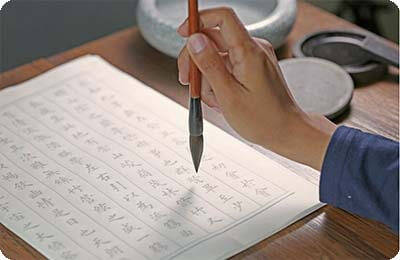朱关田纵谈书法
时间:2022-09-14 03:46:30

去年以来,记者曾多次拜访中国书法家协会副主席、浙江省书法家协会主席朱关田先生,听他纵论中国书法艺术的一系列问题,现择要整理如下:
1.您能简要谈谈经济和文化的具体联系吗?
经济与文化的具体联系,说白了就是要能够把两者结合在一起,文化是上层建筑,是靠经济的,经济能搞上去的话,文化肯定搞上去。问题是如何搞?我想导向十分重要,要引导,要重视和发扬古老的优良传统。首先是继承,要鉴别精华与糟粕,然后依据国情即人民大众需求、爱好与之前瞻,吸取精华,弃去糟粕,譬如土葬文化是种糟粕,虽然所立碑版、所窆墓志有不少书法、绘画艺术可以借鉴,但不宜以碑、志的形式再加以提倡。二是要扶持、扶植、发扬优秀传统,特别是濒临消亡或面临转化的艺术品类,如文房用具特别是毛笔,目前都是旅游性毛笔,薄利多销但不实用,更乏质量上乘能书能画的毛笔,诸多名牌毛笔因工艺陈旧,质量不好而声誉不再。现今天气变暖,狼、羊的生存环境与往昔不同,其毛质地大不同于以往,故以狼、羊毛为基本原料的毛笔制作亟待改进,工艺亟待提高。毛笔制作是手工劳动,老手艺的传承,新人才的培养,更不是立然可就的。这里有一个长期规则,有一个经济投入的问题,单靠市场运作是不行的。
2.从整体看现代经济比较发达,但深层次的文化还是欠缺的,您觉得面对这个情况我们应该怎么做?
这个很难说,整个中国经济应该说还是不够发达,而现在我看有些文化方面,学习西洋的东西有点过头,另一方面过去我们的封建流毒比较深,影响比较大,这样一来,西方文化的引进势必产生东西文化的对撞,如饮食文化上西餐与中餐的异同;医疗文化上西医与中医的差别,正因为东西文化不能替代,它只能在交流中融合,在融合中新生,这或许是时代前进的一种过程,但整个发展比较缓慢,可以说现今还未影响到文化的深层次。
3.所谓现代书法到底是一种什么概念?
现代书法有两种概念,一是现代人的书法,如唐宋书法是指唐宋人的书法一样;一是近来新产生的未成流派的流派书法,是一种艺术探索,一种传统书法走向现代、新旧交替过程中尝试的书法。现在说的后一种,因为探索路子不一,尝试手法有异,风貌与笔墨尽不相同,甚至阴阳向背,各张一军。的确,书法艺术发展至今,实用逐渐为艺术所替代,传统手法正在现代意识指导下改进或创新,多文化社会已不再满足于传统书法的表现手段,人们开始寻找一种非实用、纯艺术,既可宣示个性、展玩笔墨,又有异于绘画的书画方法,这便是现代书法的产生背景。其实,传统书法也不完全是实用的,其中草书,尤其大草、狂草,抒情写意,亦如同绘画只注重笔墨神采,很少留意文字形体,用绘画原理或西方美学去理解也是可以的,现代书法高明的便是发挥了古人写草书的手法,恣肆为之,面目一新。现代书法是一种尝试,万般手法,诸多形式,尚待检验,历史的检验,它有一个成熟过程,当然社会对其也有一个认识过程,择优汰劣,是自然规律。
4.我们说书中有画,画中有书,两者是相融的,肯定也是有区别的,那您觉得最大的区别在哪里?
区别是一个以文字为主,另一个则以形象为主,花的形象,山的形象。书法是以文字为主,如果不讲文字就成了画,画如果变成文字也就是书法了,虽然用笔是一样的。中国书法艺术历史悠久,积淀深厚,传统中有精华、有糟粕,要继承其精华,弃取其糟粕,使之发扬光大。发扬光大即是一种改造、一种创新,怎么改造、怎么创新有诸多路子,现代书法不失为一种路子,但因其仅属草创阶段,纯在形式与笔墨上下工夫,还有待于进步与成熟。在理论上有的标志西方美学,有的是老庄哲学,但作者真正能掌握的还是少数,大多是不甚理解,或以假作真,真伪不辨,更有甚者不联系自身,口是心非。傅山说:“作字先作人,人奇字自古。”现代书法是一种艺术表现,较之传统书法更追求效果,“书为心画”,作者不“艺术”何以艺术,作者不“现代”何以现代?现代书法的发展全靠作者,作者的审美观、人生观是至关重要的。
5.您觉得中国书法在整个世界文化史上具有什么样的地位?
它是一种艺术中的艺术,它是一种抽象的艺术,是一种辩证的画,它体现自己的思想,体现自己的境界是无疑的。仁智不同,你的体会和我的体会是不一样的,所以很抽象,不像画那样具象。绘画如油画、版画、水粉画各国都有,不是我国的本生画种,我国本生画是中国画,或称水墨画,原理是一致的,只有书法,仅仅是汉文字国家所专有。作为书法母国,当是至高无上的。
6.您觉得一个书法家要怎么样才能练就一手好字而又有自己的风格?
这就体现在两方面,一方面是技术方面,另外一方面是艺术方面。
从技术方面来讲,就要求多练,掌握技巧。如墨色、构图等等方面,要吸收姐妹艺术、外来文化的长处;艺术方面,书法要求写神,体验自己的经历,检验自己的审美观,什么样的人写什么样的字。至于书体最好正草并行,正书功夫所在,草书可以抒情写意。还有一个自我认识问题,特别是业余书家总要依据自身的秉性来学习,如顺谨的不必学大草、狂草,豪逸的不写楷书也可以,一个雄壮好动之人一定要他伏案写蝇头小楷,不是受罪吗?学书法一定要舒适,是一种爱好,反其道而行之成为一种苦生活,或勉为其难是没有必要的,也是学不好的。
7.现代社会上出现一些沽名钓誉和哗众取宠的人,还有些人字确实写得很好,而没有好的环境等等,您怎么看待这种情况?
从个人角度谈,应该把握好自身,不要被坏的风气所影响,把握好自己,走自己的路;从组织角度上看,要宽容。大浪淘沙么,肯定是有这样的情况,古今中外都这样,不可能全部都是黄金而没泥沙。或者说大部分是泥沙,其中极少部分才是金。那金怎么淘出来呢?要大浪冲击,千年磨洗。要相信历史,相信大众,相信社会。比如说我们绍兴的沈定庵先生,隶书写得很好,人也很低调。他一直坚持走自己的路,别人欢迎也写,不欢迎也写,始终是自己的字,凸显出自己的特色,后来他在北京的书展很轰动。沈老的路也就是我们所要走的路,所以不要把名和利看得太重。
8.您对现代中青年书法家有何感言?
作为我们来讲,只有提倡,提倡他们努力奋斗,脚踏实地地把书法搞好。至于什么方法,各人有各人的情况,也不好去强制。大众能比较,市场能审视,比较、审视中可以使中青年书法家写出更好的书法,比较中、审视中也可以教育广大中青年书法家。这里涉及到多元化的问题。可以允许有不同的做法,偶尔怪异,不合习俗性也是允许的,我们要懂得彼此宽容。
Calligrapher on Writing Art in Modern Society
Qian Rouyi, our staff reporter
Zhu Guantian, vice chairman of Chinese Calligraphers Association and chairman of Zhejiang Calligraphers Association, has talked with this writer about a series of issues concerning modern Chinese calligraphy on several occasions since 2006. The following is a summery of his main viewpoints.
In discussing the ties between culture and economy, Zhu observes that culture must synchronize its development with economy. A part of superstructure, culture depends on economy for prosperity. The problem is how to help culture progress in a right direction. The experienced calligrapher believes that it is imperative to carry forward the finest in the ancient Chinese tradition. It will be great if modern calligraphers can do so. We can absorb the best things of the western culture to help promote our culture.
In discussing the disparity between the flourishing economy and somewhat dragging cultural development, Zhu remarks that the situation is, on one hand, China”s economy is not yet well developed and the western culture has exerted an overwhelming influence on some aspects of our culture; on the other hand, the feudal ideology of the past is deeply rooted in our culture and its extensive influence persists doggedly. Consequently, we need to learn from the west to modify our cultural heritage, thus opening the door for the western culture to influence ours, which gives rise to the conflict between the two. This conflict may be part of our liberating experience, but the whole learning process has progressed only slowly and not yet touched the deepest core of our culture. In other words, our modern culture is one or two steps behind our modernizing progress.
Zhu does not go to great lengths to define modern calligraphy. In his eye, the status quo of Chinese calligraphy embodies a transition from the traditional to the modern, an art between the old and the new. Calligraphy in the past was not all for everyday use. It was an art that had various practical applications.
Talking about the future of Chinese calligraphy as an art, Zhu points out that the tradition needs reforming and there are many ways to accomplish the task. Doing the job from within the tradition is one way and learning from without is another way.
Turning to the topic of calligraphers, Zhu believes, for a calligrapher to write well in his own style, considerations should be given to both technique and art. Technically, a calligrapher should keep practicing until he masters all the skills. For example, a calligrapher should pay attention to tone and structure, and absorb other arts. Artistically, a calligrapher needs to externalize his inner world, personal experience and aesthetics. According to Zhu, one”s individual life defines one”s calligraphy.
Commenting on some calligraphers who go all out after fame and wealth as well as some calligraphers who are actually accomplished but little known, Zhu observes that a calligrapher should stick to his own path and never subjects to trends. On the other hand, the public should tolerate more liberally. Time is the final test of all arts. You can”t expect all the artists to be gold. Time sifts away large quantities of sands and only a few grains of gold remain. One needs to believe in history, people and society. Zhu takes Master Shen Ding’an for example. Also a native of Zhuji like Zhu himself, Mr. Shen is an accomplished yet little known master of official script, a calligraphic style first developed more than 2,000 years ago. Shen keeps a low profile as an artist. He has adhered to his own artistic belief despite all the odds. His calligraphy characterizes his distinct personality and style. He has held a solo exhibition in Beijing and it was a sensational success. Zhu emphasizes that Shen”s career should be a good example to all calligraphers: never put the pursuit of fame before the pursuit of art.
Any advice to young and middle-aged calligraphers? Zhu notes that all he can do is to call for hard work in a down-to-earth spirit. He does recommend that each artist explore his own way as each deals with his particular situation. The public has eyes for true art and market can well evaluate and compare. This kind of market scrutiny and public evaluation enable calligraphers to create and the choices of the public and market will serve as a signpost to calligraphers. This is an issue of multiple choices and the public tolerance is a key.
In talking about his home town Zhuji, a city rich with cultural heritage in Shaoxing, Zhu Guantian speaks highly of the calligraphic achievements accomplished by local artists but regrets that good calligraphers there are not well known to the outside world. Zhu thinks it is a good move that the local government promotes calligraphic achievements in Zhuji to help enhance the publicity of the city.
(Translated by David)